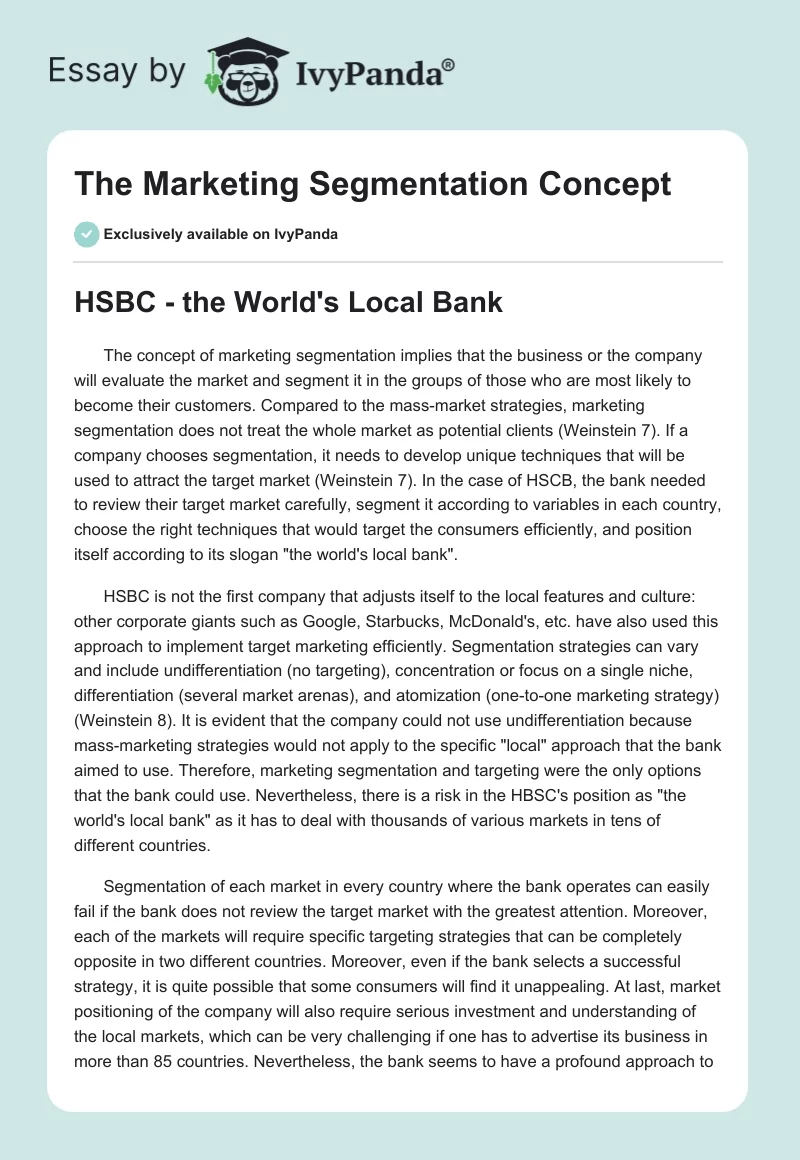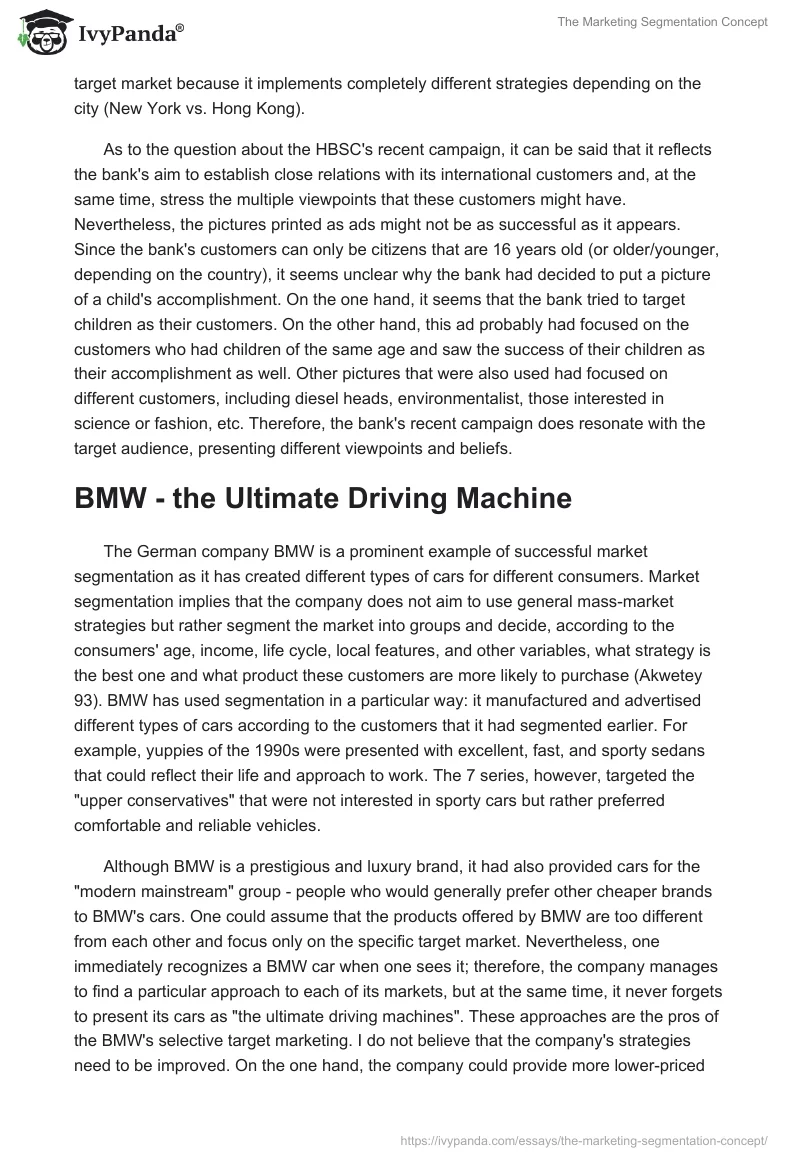HSBC – the World’s Local Bank
The concept of marketing segmentation implies that the business or the company will evaluate the market and segment it in the groups of those who are most likely to become their customers. Compared to the mass-market strategies, marketing segmentation does not treat the whole market as potential clients (Weinstein 7). If a company chooses segmentation, it needs to develop unique techniques that will be used to attract the target market (Weinstein 7). In the case of HSCB, the bank needed to review their target market carefully, segment it according to variables in each country, choose the right techniques that would target the consumers efficiently, and position itself according to its slogan “the world’s local bank”.
HSBC is not the first company that adjusts itself to the local features and culture: other corporate giants such as Google, Starbucks, McDonald’s, etc. have also used this approach to implement target marketing efficiently. Segmentation strategies can vary and include undifferentiation (no targeting), concentration or focus on a single niche, differentiation (several market arenas), and atomization (one-to-one marketing strategy) (Weinstein 8). It is evident that the company could not use undifferentiation because mass-marketing strategies would not apply to the specific “local” approach that the bank aimed to use. Therefore, marketing segmentation and targeting were the only options that the bank could use. Nevertheless, there is a risk in the HBSC’s position as “the world’s local bank” as it has to deal with thousands of various markets in tens of different countries.
Segmentation of each market in every country where the bank operates can easily fail if the bank does not review the target market with the greatest attention. Moreover, each of the markets will require specific targeting strategies that can be completely opposite in two different countries. Moreover, even if the bank selects a successful strategy, it is quite possible that some consumers will find it unappealing. At last, market positioning of the company will also require serious investment and understanding of the local markets, which can be very challenging if one has to advertise its business in more than 85 countries. Nevertheless, the bank seems to have a profound approach to target market because it implements completely different strategies depending on the city (New York vs. Hong Kong).
As to the question about the HBSC’s recent campaign, it can be said that it reflects the bank’s aim to establish close relations with its international customers and, at the same time, stress the multiple viewpoints that these customers might have. Nevertheless, the pictures printed as ads might not be as successful as it appears. Since the bank’s customers can only be citizens that are 16 years old (or older/younger, depending on the country), it seems unclear why the bank had decided to put a picture of a child’s accomplishment. On the one hand, it seems that the bank tried to target children as their customers. On the other hand, this ad probably had focused on the customers who had children of the same age and saw the success of their children as their accomplishment as well. Other pictures that were also used had focused on different customers, including diesel heads, environmentalist, those interested in science or fashion, etc. Therefore, the bank’s recent campaign does resonate with the target audience, presenting different viewpoints and beliefs.
BMW – the Ultimate Driving Machine
The German company BMW is a prominent example of successful market segmentation as it has created different types of cars for different consumers. Market segmentation implies that the company does not aim to use general mass-market strategies but rather segment the market into groups and decide, according to the consumers’ age, income, life cycle, local features, and other variables, what strategy is the best one and what product these customers are more likely to purchase (Akwetey 93). BMW has used segmentation in a particular way: it manufactured and advertised different types of cars according to the customers that it had segmented earlier. For example, yuppies of the 1990s were presented with excellent, fast, and sporty sedans that could reflect their life and approach to work. The 7 series, however, targeted the “upper conservatives” that were not interested in sporty cars but rather preferred comfortable and reliable vehicles.
Although BMW is a prestigious and luxury brand, it had also provided cars for the “modern mainstream” group – people who would generally prefer other cheaper brands to BMW’s cars. One could assume that the products offered by BMW are too different from each other and focus only on the specific target market. Nevertheless, one immediately recognizes a BMW car when one sees it; therefore, the company manages to find a particular approach to each of its markets, but at the same time, it never forgets to present its cars as “the ultimate driving machines”. These approaches are the pros of the BMW’s selective target marketing. I do not believe that the company’s strategies need to be improved. On the one hand, the company could provide more lower-priced cars to the customers with moderate income. On the other hand, BMW is a company that specializes in luxury and prestige cars, and it will seem strange if it decides to present “simpler” vehicles.
It seems unreasonable to blame BMW for too selective targeting during the global financial crisis of 2007-2008. The company was not the only one that had to face the decrease in revenues during this period. One should not forget that the corporation produces prestigious products that are mostly affordable for the members of the upper class only. The crises lead both to the decline in sales and revenues as well as stop or even reverse of the wealth grow. Therefore, those who could be described as BMW’s potential customers probably regarded the cars of the company as too expensive to purchase during the recession.
Moreover, even the wealthiest customers would approach such purchase carefully because business investment usually declines during a financial crisis, also leading to a significant decrease in consumption (Akwetey 132). The drop in sales, however, was not as severe as one could predict. The segmentation strategy of the company remained the same during the recession years, but it is highly unlikely that it was the reason why BMW experienced a decline in its sales. It could have tried to retarget the market and manufacture vehicles that would be less luxurious and more affordable. However, if production of automobile series takes approximately several years, it would be entirely unreasonable to reframe the product lines due to the recession as it only lasted for two years. Therefore, BMW met a right decision, and the decrease in sales was connected to the global recession but not to their segmentation strategy.
Works Cited
Akwetey, Lawrence Mensah. Business Administration for Students & Managers. Trafford Publishing, 2011.
Weinstein, Art. Handbook of Market Segmentation: Strategic Targeting for Business and Technology Firms. Psychology Press, 2013.


